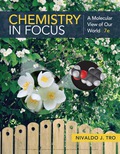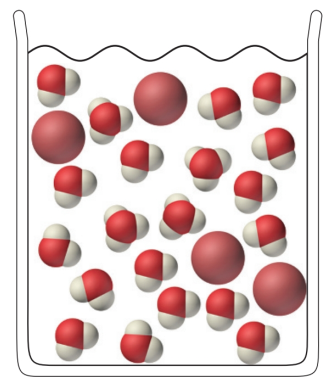
Chemistry In Focus
7th Edition
ISBN: 9781337670425
Author: Tro
Publisher: Cengage
expand_more
expand_more
format_list_bulleted
Concept explainers
Textbook Question
Chapter 13, Problem 52E
Determine from the following molecular view of a hydrobromic acid (HBr) solution whether HBr is a strong or a weak acid:

Expert Solution & Answer
Trending nowThis is a popular solution!

Students have asked these similar questions
Hi can you please help me solve this problem? thank you
Hi can you please help me solve this problem? thank you
Hi can you please help me solve this problem? thank you
Chapter 13 Solutions
Chemistry In Focus
Ch. 13 - Which property is not generally associated with...Ch. 13 - Prob. 2SCCh. 13 - The ideal pH of a swimming pool is 7.2. You...Ch. 13 - Prob. 13.1YTCh. 13 - Identify the Brnsted-Lowry acid and base in the...Ch. 13 - Prob. 1ECh. 13 - What are the properties of acids?Ch. 13 - Prob. 3ECh. 13 - Prob. 4ECh. 13 - List five common laboratory acids and their uses.
Ch. 13 - Why are bases not commonly found in foods?Ch. 13 - List four common laboratory bases and their uses.Ch. 13 - What are the Arrhenius definitions of acids and...Ch. 13 - What are the Brnsted-Lowry definitions of acids...Ch. 13 - What is the difference between a strong acid and a...Ch. 13 - Prob. 11ECh. 13 - What pH range is considered acidic? Basic?...Ch. 13 - What acid is responsible for the sour taste of...Ch. 13 - What is pickling? What acid is responsible for the...Ch. 13 - Prob. 15ECh. 13 - Prob. 16ECh. 13 - List several common acids and where they might be...Ch. 13 - Prob. 18ECh. 13 - Prob. 19ECh. 13 - What causes acid indigestion? List some common...Ch. 13 - Prob. 21ECh. 13 - Explain how a leavening agent works.Ch. 13 - Prob. 23ECh. 13 - Prob. 24ECh. 13 - Prob. 25ECh. 13 - Prob. 26ECh. 13 - Prob. 27ECh. 13 - Prob. 28ECh. 13 - Write a chemical equation to show the...Ch. 13 - Write a chemical equation to show the...Ch. 13 - Identify the Brnsted-Lowry acid and base in each...Ch. 13 - Identify the Brnsted-Lowry acid and base in each...Ch. 13 - Write a chemical equation using Lewis structures...Ch. 13 - Write a chemical equation using Lewis structures...Ch. 13 - A chemist makes two solutions. One is a 0.01-MHCl...Ch. 13 - A chemist makes a 0.001-MNaOH solution and a...Ch. 13 - Give the pH that corresponds to each solution and...Ch. 13 - Give the pH that corresponds to each solution and...Ch. 13 - What is the [H3O+] in a solution with a pH of 4?Ch. 13 - What is the [H3O+] in a solution with a pH of 11?Ch. 13 - Write chemical reactions to show how each antacid...Ch. 13 - Write chemical reactions to show how each antacid...Ch. 13 - Suppose that the stomach contains...Ch. 13 - Suppose that 250.0 mL of a basic solution is 0.100...Ch. 13 - Prob. 45ECh. 13 - Write a chemical reaction to show how NO2 forms...Ch. 13 - Prob. 47ECh. 13 - Prob. 50ECh. 13 - Determine from the following molecular view of a...Ch. 13 - Determine from the following molecular view of a...
Knowledge Booster
Learn more about
Need a deep-dive on the concept behind this application? Look no further. Learn more about this topic, chemistry and related others by exploring similar questions and additional content below.Similar questions
- An electrode process takes place at a metal-solution interface. Indicate the current condition that must be met for Faradaic rectification to occur.arrow_forwardAt a metal-solution interface, an electron is exchanged, and the symmetry factor beta < 0.5 is found in the Butler-Volmer equation. What does this indicate?arrow_forwardTopic: Photochemistry and Photophysics of Supramoleculesarrow_forward
- When two solutions, one of 0.1 M KCl (I) and the other of 0.1 M MCl (II), are brought into contact by a membrane. The cation M cannot cross the membrane. At equilibrium, x moles of K+ will have passed from solution (I) to (II). To maintain the neutrality of the two solutions, x moles of Cl- will also have to pass from I to II. Explain this equality: (0.1 - x)/x = (0.1 + x)/(0.1 - x)arrow_forwardCalculate the variation in the potential of the Pt/MnO4-, Mn2+ pair with pH, indicating the value of the standard potential. Data: E0 = 1.12.arrow_forwardGiven the cell: Pt l H2(g) l dis X:KCl (sat) l Hg2Cl2(s) l Hg l Pt. Calculate the emf of the cell as a function of pH.arrow_forward
- The decimolar calomel electrode has a potential of 0.3335 V at 25°C compared to the standard hydrogen electrode. If the standard reduction potential of Hg22+ is 0.7973 V and the solubility product of Hg2Cl2 is 1.2x 10-18, find the activity of the chlorine ion at this electrode.Data: R = 8.314 J K-1 mol-1, F = 96485 C mol-1, T = 298.15 K.arrow_forward2. Add the following group of numbers using the correct number of significant figures for the answer. Show work to earn full credit such as rounding off the answer to the correct number of significant figures. Replace the question marks with the calculated answers or write the calculated answers near the question marks. 10916.345 37.40832 5.4043 3.94 + 0.0426 ? (7 significant figures)arrow_forwardThe emf at 25°C of the cell: Pt l H2(g) l dis X:KCl (sat) l Hg2Cl2(s) l Hg l Pt was 612 mV. When solution X was replaced by normal phosphate buffer solution with a pH of 6.86, the emf was 741 mV. Calculate the pH of solution X.arrow_forward
arrow_back_ios
SEE MORE QUESTIONS
arrow_forward_ios
Recommended textbooks for you
 Chemistry for Today: General, Organic, and Bioche...ChemistryISBN:9781305960060Author:Spencer L. Seager, Michael R. Slabaugh, Maren S. HansenPublisher:Cengage Learning
Chemistry for Today: General, Organic, and Bioche...ChemistryISBN:9781305960060Author:Spencer L. Seager, Michael R. Slabaugh, Maren S. HansenPublisher:Cengage Learning General, Organic, and Biological ChemistryChemistryISBN:9781285853918Author:H. Stephen StokerPublisher:Cengage Learning
General, Organic, and Biological ChemistryChemistryISBN:9781285853918Author:H. Stephen StokerPublisher:Cengage Learning Living By Chemistry: First Edition TextbookChemistryISBN:9781559539418Author:Angelica StacyPublisher:MAC HIGHER
Living By Chemistry: First Edition TextbookChemistryISBN:9781559539418Author:Angelica StacyPublisher:MAC HIGHER Chemistry: Principles and PracticeChemistryISBN:9780534420123Author:Daniel L. Reger, Scott R. Goode, David W. Ball, Edward MercerPublisher:Cengage Learning
Chemistry: Principles and PracticeChemistryISBN:9780534420123Author:Daniel L. Reger, Scott R. Goode, David W. Ball, Edward MercerPublisher:Cengage Learning World of Chemistry, 3rd editionChemistryISBN:9781133109655Author:Steven S. Zumdahl, Susan L. Zumdahl, Donald J. DeCostePublisher:Brooks / Cole / Cengage Learning
World of Chemistry, 3rd editionChemistryISBN:9781133109655Author:Steven S. Zumdahl, Susan L. Zumdahl, Donald J. DeCostePublisher:Brooks / Cole / Cengage Learning

Chemistry for Today: General, Organic, and Bioche...
Chemistry
ISBN:9781305960060
Author:Spencer L. Seager, Michael R. Slabaugh, Maren S. Hansen
Publisher:Cengage Learning


General, Organic, and Biological Chemistry
Chemistry
ISBN:9781285853918
Author:H. Stephen Stoker
Publisher:Cengage Learning

Living By Chemistry: First Edition Textbook
Chemistry
ISBN:9781559539418
Author:Angelica Stacy
Publisher:MAC HIGHER

Chemistry: Principles and Practice
Chemistry
ISBN:9780534420123
Author:Daniel L. Reger, Scott R. Goode, David W. Ball, Edward Mercer
Publisher:Cengage Learning

World of Chemistry, 3rd edition
Chemistry
ISBN:9781133109655
Author:Steven S. Zumdahl, Susan L. Zumdahl, Donald J. DeCoste
Publisher:Brooks / Cole / Cengage Learning
General Chemistry | Acids & Bases; Author: Ninja Nerd;https://www.youtube.com/watch?v=AOr_5tbgfQ0;License: Standard YouTube License, CC-BY